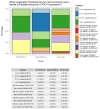Characterizing intubation practices in response to the COVID-19 pandemic: a survey of the Canadian COVID-19 Emergency Department Rapid Response Network (CCEDRRN) sites
- PMID: 38001415
- PMCID: PMC10675858
- DOI: 10.1186/s12873-023-00911-w
Characterizing intubation practices in response to the COVID-19 pandemic: a survey of the Canadian COVID-19 Emergency Department Rapid Response Network (CCEDRRN) sites
Abstract
Objective: The risk of occupational exposure during endotracheal intubation has required the global Emergency Medicine (EM), Anesthesia, and Critical Care communities to institute new COVID- protected intubation guidelines, checklists, and protocols. This survey aimed to deepen the understanding of the changes in intubation practices across Canada by evaluating the pre-COVID-19, early-COVID-19, and present-day periods, elucidating facilitators and barriers to implementation, and understanding provider impressions of the effectiveness and safety of the changes made.
Methods: We conducted an electronic, self-administered, cross-sectional survey of EM physician site leads within the Canadian COVID-19 Emergency Department Rapid Response Network (CCEDRRN) to characterize and compare airway management practices in the pre-COVID-19, early-COVID-19, and present-day periods. Ethics approval for this study was obtained from the University of Manitoba Health Research Ethics Board. The electronic platform SurveyMonkey ( www.surveymonkey.com ) was used to collect and store survey tool responses. Categorical item responses, including the primary outcome, are reported as numbers and proportions. Variations in intubation practices over time were evaluated through mixed-effects logistic regression models.
Results: Invitations were sent to 33 emergency department (ED) physician site leads in the CCEDRRN. We collected 27 survey responses, 4 were excluded, and 23 analysed. Responses were collected in English (87%) and French (13%), from across Canada and included mainly physicians practicing in mainly Academic and tertiary sites (83%). All respondents reported that the intubation protocols used in their EDs changed in response to the COVID-19 pandemic (100%, n = 23, 95% CI 0.86-1.00).
Conclusions: This study provides a novel summary of changes to airway management practices in response to the evolving COVID-19 pandemic in Canada. Information from this study could help inform a consensus on safe and effective emergent intubation of persons with communicable respiratory infections in the future.
Keywords: COVID; COVID-19; Clinical simulation; Emergency airway management; Emergency intubation; In situ simulation; SARS-CoV-2.
© 2023. The Author(s).
Conflict of interest statement
The authors declare no competing interests.
Figures





Similar articles
-
Intubation practices and outcomes for patients with suspected or confirmed COVID-19: a national observational study by the Canadian COVID-19 Emergency Department Rapid Response Network (CCEDRRN).CJEM. 2023 Apr;25(4):335-343. doi: 10.1007/s43678-023-00487-1. Epub 2023 Apr 5. CJEM. 2023. PMID: 37017802 Free PMC article.
-
Treatments, resource utilization, and outcomes of COVID-19 patients presenting to emergency departments across pandemic waves: an observational study by the Canadian COVID-19 Emergency Department Rapid Response Network (CCEDRRN).CJEM. 2022 Jun;24(4):397-407. doi: 10.1007/s43678-022-00275-3. Epub 2022 Apr 1. CJEM. 2022. PMID: 35362857 Free PMC article.
-
Improving Emergency Department Airway Preparedness in the Era of COVID-19: An Interprofessional, In Situ Simulation.J Educ Teach Emerg Med. 2020 Jul 15;5(3):S28-S49. doi: 10.21980/J8V06M. eCollection 2020 Jul. J Educ Teach Emerg Med. 2020. PMID: 37465216 Free PMC article.
-
Family presence in Canadian PICUs during the COVID-19 pandemic: a mixed-methods environmental scan of policy and practice.CMAJ Open. 2022 Jul 5;10(3):E622-E632. doi: 10.9778/cmajo.20210202. Print 2022 Jul-Sep. CMAJ Open. 2022. PMID: 35790228 Free PMC article. Review.
-
Pediatric Airway Management in COVID-19 Patients: Consensus Guidelines From the Society for Pediatric Anesthesia's Pediatric Difficult Intubation Collaborative and the Canadian Pediatric Anesthesia Society.Anesth Analg. 2020 Jul;131(1):61-73. doi: 10.1213/ANE.0000000000004872. Anesth Analg. 2020. PMID: 32287142 Free PMC article. Review.
References
Publication types
MeSH terms
LinkOut - more resources
Full Text Sources
Medical
Miscellaneous

